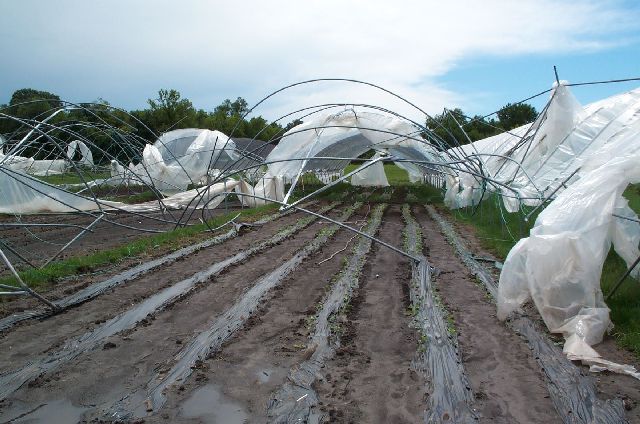Author: Natalie Hoidal, UMN Extension educator, local foods and vegetable crops
After an already tough spring, we had yet another week of severe weather that caused damage on farms across the state. The week ahead is looking moderate, with comfortable temperatures for catching up on planting. As crops slowly get established, insects are catching up quickly. In policy related news, the MN drought bill passed this week, and disaster loans are available for farmers who suffered storm related damages last month.
Crop updates
- Sweet corn and beans:
Soils across the state are finally reaching temperatures that will
allow for quick germination and growth. This is important, because when
seeds sit in cold soil too long, they are more susceptible to insects
like seedcorn maggot (which are active right now), and certain soilborne diseases.
- Cucurbits: All of our Extension pumpkin trials were planted this week. We have a couple of variety trials going on, and our colleague Charlie Rohwer at the Southern Research and Outreach Center has an exciting trial where he's intercropping pumpkins with clover. You can follow that trial and others on Twitter at @SROCHort. A few other notes about cucurbits:
- Remember that cucurbits (especially cucumbers) have very sensitive root systems and if you're transplanting later than you had intended to, they can sustain transplant damage. This is especially true if you use plastic pots, as the roots can get snagged as you remove them from trays if they are overgrown.
- Seedcorn maggots eat pumpkin / squash seeds that are direct seeded. Waiting until your soil is warm enough to plant can help prevent seedcorn maggot damage. The following photo was taken in Waseca today:
 |
| Maggots (likely seedcorn maggots) eating a pumpkin seed. Photo: Charlie Rohwer |
- Lettuce: It's been a great week for lettuce, and farmers market stands are starting to fill out with a wider variety of spring greens.
- Cole crops: Cole crops are sizing up nicely. Our black rot / Alternaria broccoli screening trials start today; 80 growers are planting a mix of 16 varieties to find varieties with some degree of disease tolerance. I've written about how the cold weather we've had this spring makes cole crops more susceptible to bolting when hot weather finally hits, so the week ahead with moderate temperatures is ideal. It's warm enough to allow them to keep growing, but likely not warm enough to trigger any bolting. In my own garden, my uncovered turnips are showing quite a bit of cabbage maggot damage this year; cabbage maggot pressure is expected to remain an issue for at least another week or two.
 |
| Cabbage maggot damage to a turnip root. Photo: Natalie Hoidal |
- Tomatoes and peppers: Most people (aside from perhaps the Iron Range growers) have their tomatoes and peppers out in the field. With the cold week ahead, expect slow growth, and potentially some minor cold damage, which plants should grow out of. With the cold wet spring, many growers have tomatoes and peppers that already have some disease pressure, particularly from gray mold and bacterial spot. Check out Marissa's article about how to handle these diseases once your plants leave the transplant house.
- Garlic: I'm seeing more and more "green garlic" being sold at farmers markets in the last couple of years. If it makes sense for you financially, this is a nice way to offer customers something interesting in addition to the abundance of greens and radishes in the spring, and a way to free up bed space if you're growing in a small space.
 |
| "Green garlic" Photo: Andrea Nguyen, Flickr |
- Potatoes: Potatoes are beginning to emerge. The first alfalfa harvests are beginning this week, so anticipate some movement of potato leafhoppers. These insects are tiny and hard to spot, so they often go unnoticed, but they can cause substantial yield loss. If you're growing very close to an alfalfa field, watch your neighbors fields, and consider scouting with a sweep net soon after they cut their alfalfa.
Soil temperature report
Soil temperatures from MDA stations, data collected to 6’’ depth
|
Station location |
Nearest major town |
Coldest soil temperature in the last 7 days (approx.) |
Temperature on May 31, 2022 (approx). |
|
Blue Earth |
Albert Lea (Iowa border) |
55 º F |
64 º F |
|
Russel |
Marshall |
54 º F |
63 º F |
|
Henderson |
St. Peter / Belle Plaine |
55 º F |
66 º F |
|
Hoffman |
Alexandria |
49 º F |
60 º F |
Soil temperatures from ND-managed stations in MN
|
Station location |
Nearest major town |
Approximate turf soil temp on May 31 (4’’) |
|
Sabin |
Fargo / Moorhead |
60 º F |
|
Mavie |
Thief River Falls |
56 º F |
|
Fox |
Roseau (Canada border) |
57 º F |
Problems in the field / things to do this week
Drought relief! Plus: Infrastructure destroyed in storms
 |
| Tunnel damage after storms. Photo credit: Ted Carey, Kansas State University via eOrganic. |
Irrigation water testing
 |
| A low-tech way to acidify irrigation water. Photo: Natalie Hoidal |
Comments
Post a Comment